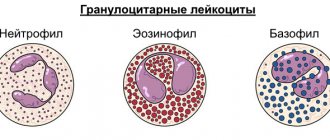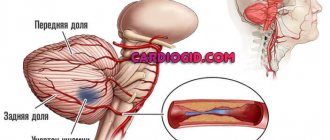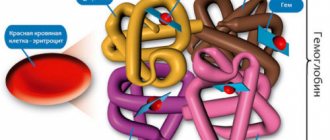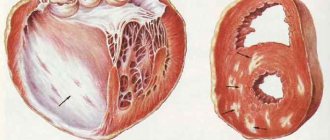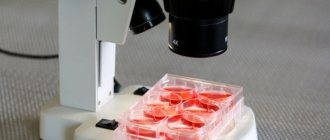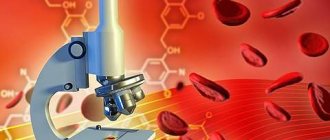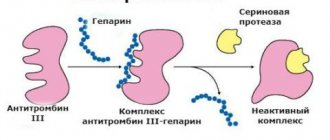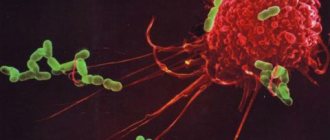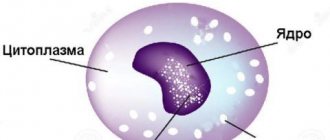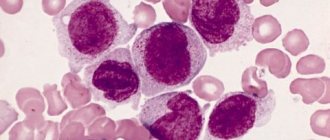Immature granulocytes are a type of leukocyte - white blood cells that differ in appearance and function in the body. This group includes promyelocytes, myelocytes and metamyelocytes. They got their name because granules are visible when microscopically stained.
Normally, immature granulocytes should be present in the bone marrow and not in the peripheral blood. They can be elevated in an adult, both as a result of physiological reasons and in certain diseases. The analysis is often prescribed for the diagnosis of infectious and tumor processes.
What does a granulocyte test show?
Immature granulocytes are elevated in adults - a marker of a pathological left shift in the leukocyte blood count. Mature cells are the basis of “white blood” or leukocytes, the main function of which is the body’s immune defense. Granulocytes make up up to 80% of the total number of leukocytes.
Immature cells of this type are produced in the bone marrow and appear in the blood in two cases - with a deficiency of mature granulocytes and to replace old forms (normal levels in the blood).
Their circulation in plasma is short - about 6-7 days, and their lifetime in tissues is on average 2 days. Since the biological cycle of cells is very short, their number in the blood should normally be minimal.
A disruption of the circulation mechanism of immature granulocytes indicates a deterioration in the body’s “line of defense”, a decrease in its resistance to infectious and other diseases, since the cells that subsequently form are responsible for the production of antimicrobial, antiparasitic and anti-inflammatory substances.
When the pathological process is activated, granulocytes begin to die faster and there are not enough of them. To replenish the supply, immature forms of cells enter the bloodstream, designed to fill the “gap” in the immune defense.
Immature granulocytes are increased in adults. What does this mean, the norm, reasons for women, men
Good afternoon, many will be interested in understanding their health and their loved ones, and I will tell you my experience, and we will talk about what an increase in immature granulocytes in a blood test indicates. Most likely, some details may differ, as was the case with you.
Please note that you should always consult with highly specialized specialists and not self-medicate. Naturally, you can quickly find the answer to the simplest questions and diagnose yourself.
Write your questions/suggestions in the comments, and together we will improve and supplement the quality of the material provided.
Quantitative changes in granulocytes during pregnancy
The number of granulocytes in the bloodstream does not depend on the gender of the patient. However, in women during pregnancy, the percentage of these cells may be increased. An increase in granulocytes is associated with the release of a large amount of estrogens during this period. The peak of these cells in the blood is observed at 30 weeks of pregnancy.
During labor, the number of leukocytes increases, thereby increasing the number of immature granulocytes. Neutrophil levels in pregnant women are about 3%.
Taking a blood test
They examine blood if there is a suspicion of many infectious diseases and more. Thus, immature granulocytes are detected during a complete blood test. Blood is drawn from a finger. In emergency situations, blood can be taken from a vein.
There are a number of rules that will help make the analysis results “truthful”:
- Blood is donated on an empty stomach.
- A couple of days before the test, it is forbidden to drink alcohol, fatty and salty foods.
- You should also avoid heavy physical activity.
- It is strongly recommended not to take various medications before the study.
The counting of cellular elements occurs automatically, so the results are obtained as accurately and quickly as possible. The final results can be collected the next day.
The following abbreviations are found in the analysis results:
- Abs – means the “absolute” indicator of the number of cells in 1 liter of blood,
- Lic – indicates the presence of large immature cells.
Immature granulocytes are a group of cells that are the first to respond to the appearance of various pathological processes in the human body.
Immature granulocytes are detected in a detailed blood test during bacterial and viral infections and allergic conditions.
Granulocytes: what kind of cells are they, their types, functions
Granulocytes are white blood cells that have granularity. They have a sickle-shaped core. Structurally divided into several segments (up to 5). They make up up to 80% of all leukocytes. These cells arise in the bone marrow and live there. Once in the tissue, granulocytes do not live long - no more than 3 days.
When a foreign agent (bacterial flora or virus) enters the body, granulocytes absorb it and die. If for some reason there are not enough granulocytes to fight infection, their immature forms begin to flow from the bone marrow into the blood. The presence of young forms of cells in the blood indicates serious pathologies: allergies, autoimmune disorders, sepsis.
The following types of granulocytes are distinguished:
| Neutrophils | Responsible for cellular immunity. They perform phagocytosis, like monocytes. Neutrophils surround pathogenic cells, capture them and digest them. Then the cells die on their own, causing the formation of pus. |
| Eosinophils | They are also capable of phagocytosis, but absorb smaller “opponents”. Their main task is to bind mediators of inflammation and allergies (histamine). |
| Basophils | Large cells that contain special granules. When an allergen enters the body, they release these granules to bind it to them. In the process, blood flow and vascular permeability around the site of inflammation increases. Basophils signal monocytes and eosinophils about a pathological threat, calling them to the site of inflammation. |
Neutrophils, in turn, are divided into:
- Mature or segmented.
- Not quite ripe or rod-shaped. They do not live long in this form: very quickly their nucleus is deformed, segments are formed, and the cells become mature.
- Immature granulocytes.
This position of cells in a blood test is as follows: from left to right, first young granulocytes are located, then band and segmented ones.
Human immune system
A sharp shift in the leukocyte formula is determined in myelomonocytic leukemia, as well as in purulent processes. Not only the number of granulocytes changes, but also the “quality” of their cells.
Pathological causes
The appearance of immature granulocytes in the blood indicates, first of all, that there is an inflammatory process in the body.
If immature granulocytes are elevated in a child's blood, parents should not suspect the worst, such as leukemia.
It’s sad that this happens, but most often an increased number of immature leukocyte cells is associated with more harmless pathologies:
- acute infectious diseases,
- burns, cuts with the formation of suppuration,
- acidosis (shift of the acid-base balance towards acidity).
When is the test ordered?
Determining the number of leukocytes and one of their varieties, immature granulocytes, is one of the most common laboratory tests. It is carried out as part of a clinical (“general”) blood test, but on the referral the doctor must indicate that a decoding of the leukocyte formula is required.
The study is prescribed in the following cases:
- during routine medical examinations;
- to analyze the general state of immunity, assess the body’s ability to resist infections of a viral and bacterial nature;
- for allergic pathologies;
- for the diagnosis of leukemia and other diseases;
- to assess the effectiveness of therapeutic measures and the dynamics of the pathological process;
- if it is necessary to hospitalize the patient in a hospital;
- before surgery.
A referral to the laboratory can be given by a doctor of any specialty.
Reasons for rejection
Although an increase in band neutrophils in itself is not a specific sign of infection, it is often present with:
- inflammatory processes;
- tissue damage and necrosis;
- neoplasms;
- intoxications;
- metabolic abnormalities;
- bleeding;
- hemolysis;
- using medications.
Due to the wide variety of reasons for the appearance of band neutrophils in the blood, their nonspecificity and the labor-intensive counting process, their indicators are used mainly to assess the health of seriously infected patients whose band neutrophils have increased due to the disease and medications used. But here, too, not everything is clear.
Recently, clinical studies have been conducted on the extent to which band leukocyte counts can be used to distinguish patients with bacterial infection from healthy patients. Most of the ongoing work has yielded unsatisfactory results with low sensitivity and specificity. Studies have shown that the number of band neutrophils is not significant in distinguishing infected from uninfected patients. The only study that showed satisfactory sensitivity and specificity was in patients with diabetic ketoacidosis.
Counting band leukocytes is also widely used in diagnosing newborns less than three months old. If a child's band neutrophils are elevated, this indicates a bacterial infection.
The norm in children under 3 weeks of age for band leukocytes in a blood test is from 0 to 20%. On the first day of birth, a child’s neutrophils can normally increase to 81%. However, not all researchers agree that the indicators of band leukocytes, even in children with an increased number of this type of leukocytes, really give a satisfactory result.
Therefore, it must be emphasized once again that counting an increased rate of band neutrophils is an unreliable indicator for determining a bacterial infection. For this reason, many hematology laboratories have discontinued band neutrophil testing.
A much more accurate indicator is to count the total number of neutrophils. It should be noted that with an increase in the total number of neutrophils, the number of immature band leukocytes usually increases, especially in acute inflammation.
It is much more reliable to use the levels of total leukocytes and neutrophils for diagnosis, which are carried out using automated equipment. In addition, it is believed that the analysis of band neutrophils has no future, since the development of precision blood tests is moving towards the rapid analysis of inflammatory factors, cytokines, neutrophil surface antigens and bacterial DNA. These tests are much more effective, for example, for the early diagnosis of sepsis.
Norms of indicators
Immature granulocytes are increased in adults in analyzes and can be in absolute and relative terms. Normally, they should be completely absent from the blood, but a small amount is still allowed.
The relative content of cells of this type on medical forms is indicated under the designation IMM% and is expressed as a percentage of the total number of granulocytes, and the absolute content is IMM#, the units of measurement of which can be g/l or 109/l in different laboratories.
In men
In healthy men, the number of immature cells should not exceed 5% or 0.07*109/l. In boys during puberty, this figure in relative terms can reach 6%.
Immature granulocytes increase in adults and children when the body is sick
With an increase in the content of immature granulocytes, additional examination and clarification of the anamnesis are required in order to determine the cause of the deviation and make a diagnosis. In doubtful cases, the doctor may prescribe a repeat test.
Among women
There is no difference in normal values for men and women, since the leukocyte formula is practically independent of gender. In children, the ratio of mature and immature cell forms differs from adult values.
Immature granulocytes
Detailed blood test - shows reliable information about a person’s health.
By assessing this indicator, you can quickly identify negative deviations and take timely steps to improve the health of the human body.
A group of cells that take the first blow, identifying infections and pathologies - blood granulocytes. Let's take a closer look at this type of cell, and also find out what immature granulocytes indicate by their presence in the analysis.
What it is
So, let's consider what this phenomenon is - the presence of immature granulocytes in a general blood test.
Granulocytes, also called granular leukocytes, are a subtype of white blood cells with an irregularly shaped nucleus, divided into lobe-segments (from 2 to 5 pieces) and special granules, which are revealed under a microscope as a result of special staining.
They are mature and immature. They are characterized by the place of their production in the body - the bone marrow, as well as a fairly short life cycle, no more than three days.
Photo of a granulocyte under a microscope
Granulocytes make up about 80% of the total proportion of “white” blood. In turn, they consist of 70% neutrophils, about 5% eosinophils, up to 1% blood basophils, etc. Each component is necessary for the process of identifying and protecting against pathogenic microflora.
If pathogenic flora enters the human body, granulocytes detect them and absorb them, destroying them within themselves.
Unlike other representatives of the leukocyte series, for example, blood lymphocytes, granulocytes do not have memory and cannot develop immunity to diseases familiar to them, since after several days, having completed their task, they die, and this is how their deficiency is revealed.
In a normal state, granulocytes do not leave their place of birth - the bone marrow, but when all the working neutrophils are involved in the blood, their deficiency is formed. That is, immature neutrophils immediately come to support the remaining granular cells, but they can already be detected during a blood test.
An increase in the level of young granulocytes in the blood indicates problems in the body: an increase in various components can indicate all kinds of inflammation, allergic processes, autoimmune diseases, infections caused by bacteria or viruses.
In a clinical blood test, the absence of granulocytes is considered favorable, however, the presence of immature neutrophils in newborns and pregnant women is an exception.
Norm
Since the cells mature very quickly, this number of neutrophils in the general group of white blood cells - leukocytes - will be considered normal:
- mature - up to 65%
- unripe - up to 5%
The norm of immature granulocytes for adults and children is different: for an adult the figure is 45-70%, but for children of different ages these data differ.
For convenience, we use the table:
| Age | Number of cells, % |
| mature | immature |
How to prepare for research
The concentration of immature granulocytes is determined as part of a clinical blood test.
General preparation rules are as follows:
- 12 hours before submitting the biomaterial, you must refuse to eat, you can only drink still water;
- the last meal should be light (early dinner), tea and coffee are excluded;
- During the day before, you should not eat fatty or fried foods;
- 2-3 days (or at least 1 day) before visiting the laboratory you should give up alcoholic beverages;
- per day, it is also necessary to exclude heavy physical activity, visiting a bathhouse, sauna, and try to avoid emotional stress;
- 1 hour before submitting the biomaterial, smoking is prohibited;
- immediately before taking blood, you need to rest for 10-15 minutes; it is also recommended to warm your hands to improve blood circulation.
The analysis is carried out in the morning from 8-00 to 11-00. If other diagnostic or physiotherapeutic procedures are prescribed on the same day, they should be carried out after this.
How the biomaterial is collected
The technique for collecting biomaterial consists of the following sequential steps:
- The patient is seated on a chair at the nurse's table, his left hand is placed on the table.
- The puncture site - the ring finger of the left hand - is wiped with a cotton swab soaked in medical alcohol (or an alcohol wipe). Blood is taken from this finger because it has a synovial vagina that prevents the spread of infections. If this fails, then the fence is made from another finger. In young children, the test can be taken from the heel. In rare cases, blood is taken from the earlobe.
- A puncture is made with a disposable needle in an applicator or with a lancet (sharply sharpened plate). The first method is less painful. The puncture should be made on the side surface of the fingertip, since there are more blood capillaries and fewer nerve endings there.
- The nurse removes the first drop of blood with a dry cloth. It contains many fabric elements, so it is not used. During blood transfusion into the test tube, you should not massage the puncture site so that foreign substances do not get into the biomaterial. To help the blood flow out better, the nurse may apply gentle pressure to the finger in the area above the puncture.
- Blood is drawn into a capillary and transferred to a test tube (or immediately into a test tube with a short capillary, which is subsequently removed from it).
- The puncture site is pressed for 5-10 minutes. alcohol wipe or cotton swab soaked in alcohol.
Decoding analysis responses
Immature granulocytes and interpretation of their blood levels are assessed in conjunction with other clinical data.
Thus, if they are increased by more than 2% in an adult after cardiac surgery, this indicates a high risk of developing infectious and inflammatory complications. When sepsis is detected, an increase in the concentration of immature cells reduces the patient's chances of survival.
On the other hand, there are categories of patients in whom exceeding the 5% threshold may not be a sign of pathology.
These include the following persons:
- women during menstrual bleeding;
- pregnant women;
- newborns;
- patients exposed to chronic stress or constant heavy physical activity.
Reasons for growth
Granulocytes are elevated - what does this mean? The reasons for the growth of granulocytes can be different. This is primarily due to inflammation in the body.
The main ones include:
- Infectious diseases of the acute stage.
- Infections caused by parasites.
- Pathologies with narcotic development.
- Intoxication of the body.
- Oncological diseases.
- Vaccinations.
- Allergic reactions.
- Taking medications.
An increase in neutrophils can be caused by:
- taking certain medications;
- endogenous intoxications;
- acute infections caused by bacteria.
The growth of eosinophils indicates the development of:
- malignant tumors;
- heart diseases;
- diseases of cartilage tissue;
- disorders of the body's immune function;
- inflammation caused by parasites;
- skin pathologies.
Elevated basophils occur due to:
- Manifestations of an allergic reaction.
- Blood diseases.
- Taking medications.
- Hodgkin's syndrome.
- Inflammation of the gastrointestinal tract.
Reasons for leveling up
An increase in the concentration of immature granulocytes is observed with the development of pathologies such as:
- malignant processes, leukemia;
- infectious diseases of various localizations (typhoid fever, malaria, tuberculosis, rubella, meningitis, pneumonia, pyelonephritis and others);
- systemic inflammatory response syndrome during major surgical interventions;
- liver diseases - cirrhosis and hepatitis;
- autoimmune disorders;
- extensive burns or heavy bleeding;
- severe intoxication;
- allergy;
- acute inflammatory processes (abscesses, peritonitis, appendicitis, phlegmon and others).
Life cycle and functions of granulocytes
All types of granular leukocytes originate from a single stem cell in the red bone marrow. Here, over several stages, the process of their differentiation into neutrophils, basophils and eosinophils occurs. Depending on the degree of maturity, cells are distinguished:
- Young
- Immature (rod)
- Mature (segmented)
The entire cycle of granulocyte maturation takes place in the red bone marrow, after which the formed cells enter the bloodstream. A slight presence of immature forms of granular leukocytes in the blood is also considered a normal variant.
Once in the bloodstream, granulocytes are divided into two populations: freely circulating and mural. Parietal standing is an intermediate phase of the life of these cells before entering the tissues, where they move freely and perform their main functions - protective. With the development of inflammatory processes and the detection of external invasion under the influence of bioactive mediators, the parietal population increases, and leukocytes begin to actively migrate to the lesion.
All types of granular leukocytes have the ability to move and phagocytose to one degree or another, but each type has its own special functions:
- Neutrophils are microphages capable of destroying relatively small foreign particles. Contains enzymes that have an antibacterial effect.
- Eosinophils can both trigger and suppress allergic reactions in lesions and participate in the production of cytotoxic substances (cellular poisons), mainly with antiparasitic effects.
- The contents of basophil granules ensure the development of local reactions that contribute to the migration of other granular leukocytes to the site of inflammation
After the cells exit into the tissue, the countdown of the granulocyte life cycle begins. Depending on the type of cell and accompanying conditions, their lifespan ranges from 2 to 10 days.
What could affect the validity of the study?
The following factors may affect the results of the analysis:
- patient failure to comply with preparation rules;
- use of medications (you must notify your doctor about taking them in advance; you may need to stop taking them a few days before donating blood);
- laboratory technician errors - uneven distribution of blood cells on the smear (this depends on the qualifications of the personnel), incorrect counting of immature granulocytes, statistical error.
Blood testing in automatic analyzers is the most preferable, since up to 30,000 cells are studied, while with the microscopic method - only 100.
How much does the study cost, where is it carried out?
A test to determine the level of immature granulocytes in the blood can be carried out in any laboratory specializing in diagnostic procedures.
The average cost of a clinical blood test with a leukocyte formula in commercial medical institutions is about 400 rubles. If blood must be drawn from a vein, you will need to pay an additional 130-250 rubles. Some laboratories provide this service by visiting the patient’s home.
GRA in blood test: normal values
Only a doctor can correctly decipher the result of the study. This is due to the fact that based on an increase or decrease in the number of any cells, it cannot be guaranteed that there is a pathology. If the development of the disease is suspected, it is necessary to conduct a comprehensive diagnosis. With the help of analysis, it is only possible to suspect the course of the pathological process.
It is important to understand that granulocytes are cells that must be present in the body of every person. Normal indicators directly depend on a person’s age:
- 12 months - 31%;
- up to 10 years - 51-53%;
- 10-16 years old - 53-57%;
- 16-21 years old - 59%.
In newly born children, the granulocyte level should be 35%. In adult women and men, the normal rate is 47-72%. Some laboratories use other units of measurement. In adults, the norm of granulocytes is 1.2-6.8 x 109 (in 1 liter of blood).
It is important to remember that granulocytes are a group of cells that includes several functional units. When decoding the study, it is necessary to pay attention to their indicators.
GRA norm in blood test:
- Basophils. In children under 12 months, their level should be at least 0.4% and no more than 0.9%. In adolescents and adults, the normal rate is 0.6-1%.
- Eosinophils. The level of these cells directly depends on the degree of functioning of the adrenal glands. The norm is 120-350 (in 1 ml of blood). In the morning their level can be increased by 15%, at night (in the first half) - up to 30%.
- Neutrophils. These cells are divided into rod and segmented. The number of the former should not exceed 6%. The norm for segmented neutrophils is 40-70%.
As a rule, if granulocytes are increased or decreased, this means that a pathological process is developing in the body. However, sometimes deviations from the norm can occur for physiological reasons. In women, granulocytes are elevated before menstrual bleeding, in the third trimester of pregnancy and during the delivery process. In both sexes, deviations from the norm to a greater extent may be a consequence of overeating and high-intensity physical activity.
The presence of immature granulocytes in the blood is not a pathology. This is explained by the fact that the life cycle of granular leukocytes is only a few days. In other words, the change to young cells occurs very quickly, the number of the latter ranges from 1 to 5%.
Normalization of indicators
Abnormality in itself for immature granulocytes is not diagnostically valuable. A pathological violation of indicators must be accompanied by other symptoms. To identify the cause of a high level of immature cells, additional instrumental and laboratory diagnostics are necessary.
In this regard, independent treatment is not recommended, since diseases in which changes in granulocytes occur are diverse in nature and require a completely different therapeutic approach, both conservative and surgical. Below are the most common causes and remedies for this condition.
For preventive purposes, it is necessary to systematically undergo medical examinations for early detection of pathologies, adhere to a healthy lifestyle, avoid infectious diseases, and strictly follow doctor's instructions in the presence of diseases.
Medicines
The table below shows the main methods of treating diseases in which the level of immature granulocytes increases:
| Group of diseases | Disease | Essential drugs |
| Infectious pathologies | Typhoid fever | Antibacterial agents: fluoroquinolones (Ciprofloxacin, Pefloxacin, Ofloxacin, Gatifloxacin), cephalosporins (Ceftazidime, Ceftriaxone, Cefotaxime, Cefixime), macrolides (Azithromycin) Gastrointestinal motility stimulants (Domperidone, Metoclopramide) Enterosorbents (Polymethylsiloxane polyhydrate, Rekitsen-RD, Pektovit) Antidote Dimercaprol |
| Malaria | Antimalarial drugs (Chloroquine, Hydroxychloroquine, Primaquine and others) | |
| Tuberculosis | Anti-tuberculosis drugs (Isoniazid, Rifampicin, Rifabutin, Pyrazinamide and others) | |
| Rubella | There is no specific treatment; Paracetamol is used to eliminate symptoms | |
| Meningitis | Antibacterial agents (Penicillin, Ampicillin, cephalosporins, carbapenems) | |
| Pneumonia | Broad-spectrum antibiotics (cephalosporins, macrolides, carbapenems, fluoroquinolones) | |
| Pyelonephritis | Antibacterial agents (Penicillin, aminoglycosides, fluoroquinolones, cephalosporins) Painkillers, antipyretics and other drugs for symptomatic treatment | |
| Liver diseases | Cirrhosis | Hepatoprotectors (Essentiale Forte, Phosphogliv, Antraliv, Essliver, Phosphonziale, Rezalut Pro, Gepatrin) |
| Hepatitis | Hepatoprotectors (Methionine, ursodeoxycholic acid, essential phospholipids) Means for normalizing the gastrointestinal tract (lactulose, lacto- and bifidobacteria) | |
| Burns | — | Infusion therapy Local antibacterial drugs (hydrogen peroxide, potassium permanganate, nitrofurans, Levomycetin, Erythromycin, Sulfonamides) Painkillers |
| Intoxication | — | Enterosorbents (activated carbon, Filtrum and others) Antidotes |
| Allergy | — | Antihistamines (Suprastin, Tavegil, Diphenhydramine, Diazolin, Claritin, Fenistil and others) |
Folk remedies
Immature granulocytes are elevated in an adult for various reasons. To eliminate them, appropriate traditional medicine recipes are selected.
Oncological pathologies are treated using plant poisons:
- Decoction of celandine. 1 tbsp. l. herbs of this plant, the same amount of plantain, 2 tbsp. l. lemon balm, nettle leaves, horsetail, 1 tbsp. l. dandelion roots are mixed. 2 tbsp. l. collection pour 3 tbsp. water and boil. Drink 1/3 tbsp of the decoction. 3 times a day before meals.
- Hemlock tincture. The inflorescences and leaves of the plant are placed in a glass jar and filled with alcohol (ratio 1:3). Keep for a month, then filter. Take the product on an empty stomach in the morning, starting with 1 drop diluted in 100 g of water. Gradually this amount is increased to 30-40 drops.
For infectious diseases, the following recipes are used:
- Pyelonephritis - decoctions of bearberry (2 tbsp. per 0.5 l of boiling water, drink 2 tbsp. 3-4 times a day), lingonberry (2 tbsp. per 1.5 tbsp. boiling water, drink as follows) same scheme), juice or fruit drink from cranberries (2 tbsp. per day).
- Pneumonia:
- 2 tbsp. Chop the peeled garlic, squeeze out the juice and pour it into a jar with 1 liter of Cahors. Leave for 1 week. Drink 1 tbsp. l. 3 times a day.
- Chop 2 large onions, pour 1 tbsp. hot milk, boil for 5 minutes. Strain, take 1 tbsp. l. every hour (in acute illness).
The following effective methods are used for liver pathologies:
- Cut off the top of a medium-sized ripe pumpkin, clean out the seeds from the inside and fill it with flower honey. Close the resulting “barrel” and keep it in a dark, dry place for 2 weeks. Take this remedy for a month.
- Squeeze beetroot and carrot juices, mix them in a ratio of 1:5. Drink 1 tbsp. before meals 3 times a day.
- Chop young branches of weeping willow, put in a saucepan and pour 3 liters of boiling water. Leave for 1 night, strain. Drink throughout the day instead of tea. Keep refrigerated.
Diet therapy
General nutritional rules for the above diseases are as follows:
- food intake should be regular, in small portions;
- Steamed and boiled dishes are preferable;
- the diet should be nutritious and varied;
- It is necessary to exclude fried, canned, spicy, fatty foods, coarse fiber, as they irritate the gastrointestinal tract.
Dietary recommendations for this symptom depend on the characteristics of the disease. So, with pyelonephritis, it is necessary to follow a dairy-vegetable diet; salt intake is limited to 5 g per day. In case of liver cirrhosis, the protein content should be at least 1 g per 1 kg of body weight daily. There are other nutritional features that your doctor should be familiar with.
Quantitative indicators
If granulocytes are elevated, the cause is the spread of infection throughout the body. The analyzes indicate quantitative values of the norm ranging from 1.2 to 6.8 per 10 to the 9th power. This total number may not change, but the ratio of neutrophils, basophils, lymphocytes and eosinophils varies. Indicators are indicated as percentages:
- Basophils depend on age: up to 1 year from 0.4 to 0.9%, up to 21 years from 0.6 to 1%.
- For eosinophils, the norm is from 120 to 350 per 1 ml of blood. In the morning, the normal values exceed 15% of the normal state, in the first half of the night - by 30%. Fluctuations in values occur with changes in the functioning of the adrenal glands.
- Neutrophils can normally be band-nuclear - no more than 6% and segmented - no more than 70%, but not less than 40%.
Prognosis and complications
If a slight increase in the level of immature granulocytes within normal limits is not accompanied by other pathological symptoms, then this condition does not pose a danger to human health.
With advanced pathologies, serious metabolic disorders, decreased immunity and other complications accompanying the disease are possible (up to death in hepatitis, cirrhosis, malignant and infectious processes).
The prognosis of the disease depends on its type, timely diagnosis and treatment. Therefore, if a leukocyte shift is detected in the blood, it is necessary to undergo a full examination in accordance with the doctor’s prescriptions.
Immature granulocytes in themselves are not a sign of a specific disease. If they are elevated in an adult, then additional examination is required. The results of the analysis are taken into account in conjunction with other information. One of the most common reasons for an increase in their number is infectious and inflammatory pathologies.
Article design: Vladimir the Great
Why does the level change?
Over the course of nine months, a woman takes a blood test
It is important that all indicators have values within acceptable limits, including band neutrophils, which occupy a large part in the chain of leukocytes. A shift in PN values from the limit values in a blood test indicates suspicion of a particular disease at an early stage
Therefore, it is important to identify and eliminate the causes of deviations in a timely manner. Neutrophils are responsible for the state of immunity and warn of the onset of inflammatory or infectious activity in the body.
Norm PN in the blood for adults and adolescents over 13 years of age:
- percentage rate - from 40 to 70%;
- acceptable changes are 1–7.
During pregnancy, the immune system weakens. This is a genetic reaction to a foreign object that grows in the uterine cavity. As the fetus develops and pregnancy progresses, a large amount of toxins—the baby’s waste—enters the woman’s bloodstream. Because of this, the level of neutrophils increases, changing the leukocyte formula.
For nine months, a woman needs to keep her blood counts under control. Timely tests can prevent the development of spontaneous miscarriage or premature birth.
From the eighth week of pregnancy, the level of neutrophils increases, and stabilization of this value occurs at the end of the second and beginning of the third trimester. The band values do not exceed 70%, and the number of lymphocytes remains unchanged.
An increase in indicators indicates that the body is actively fighting replenishment or infection. A decrease in the permissible limit level of 40% indicates a similar situation. In the latter case, this is dangerous for the pregnant woman, because she may not be aware of the health problems, since in the early stages the disease is asymptomatic.
